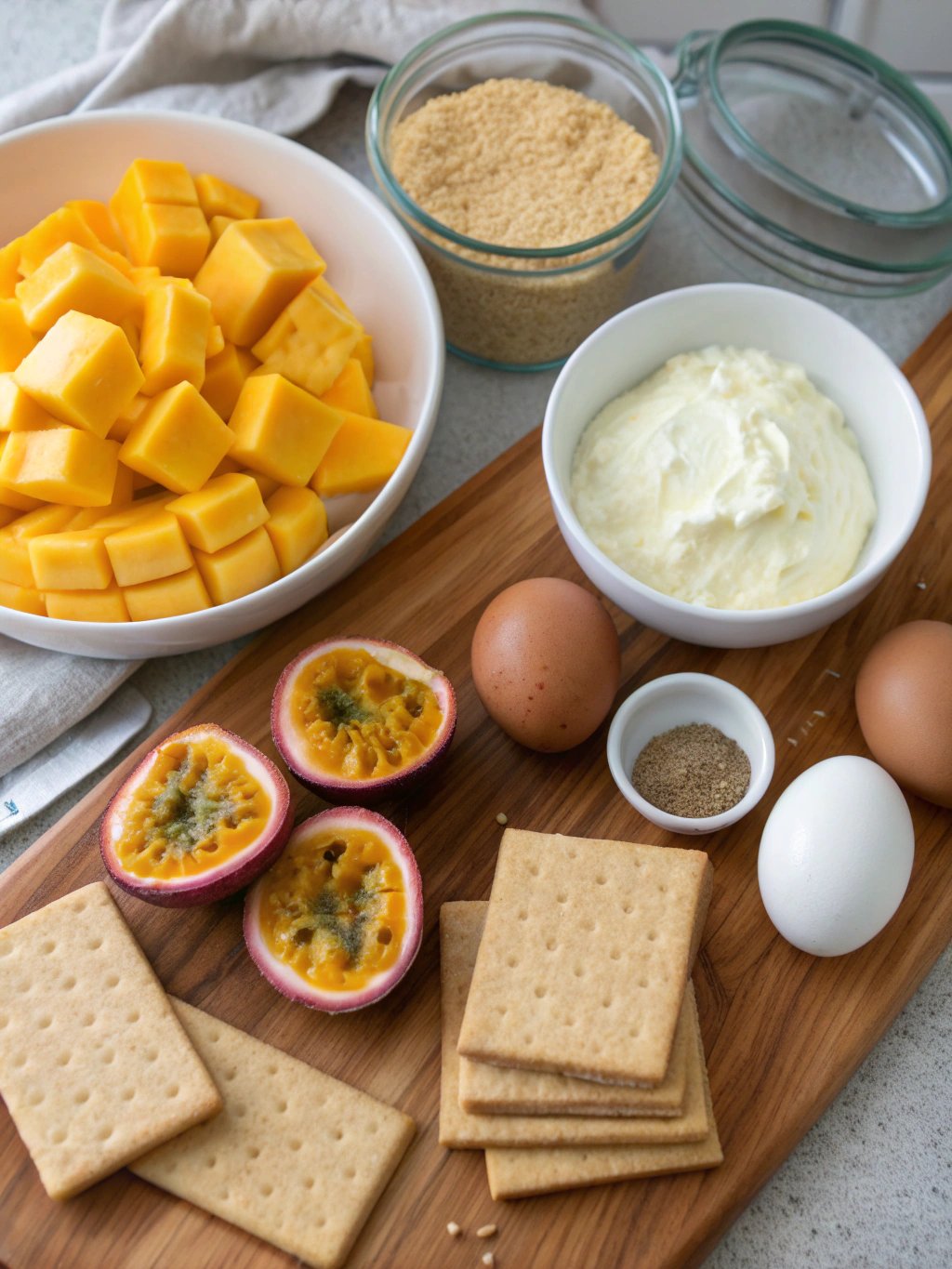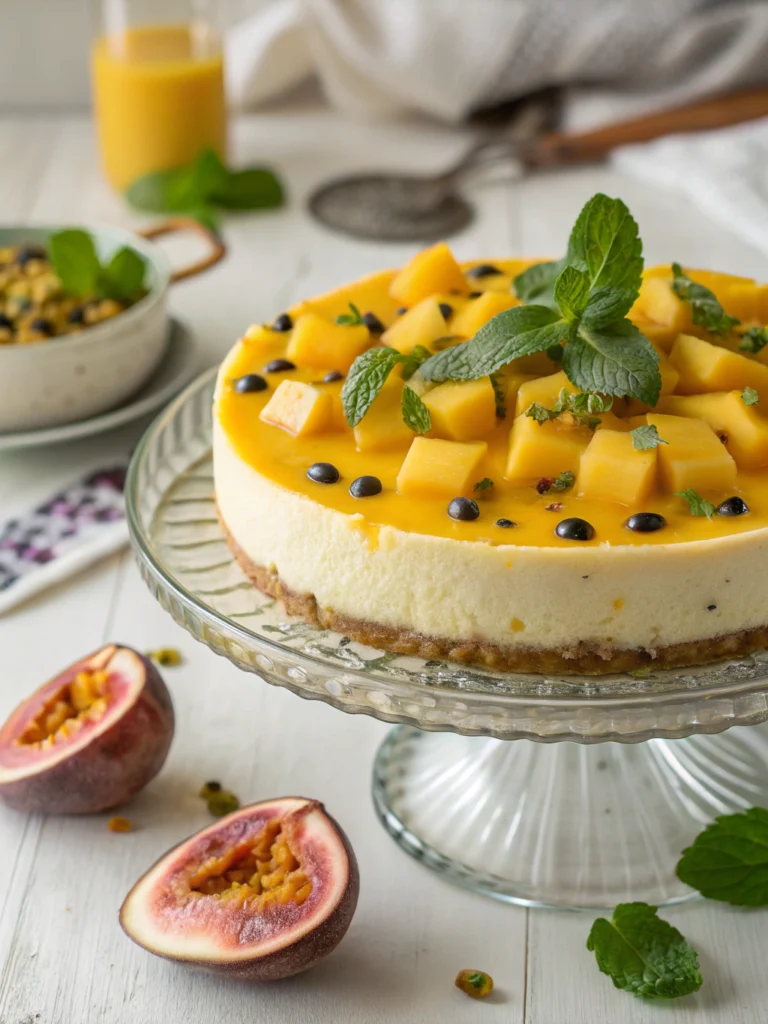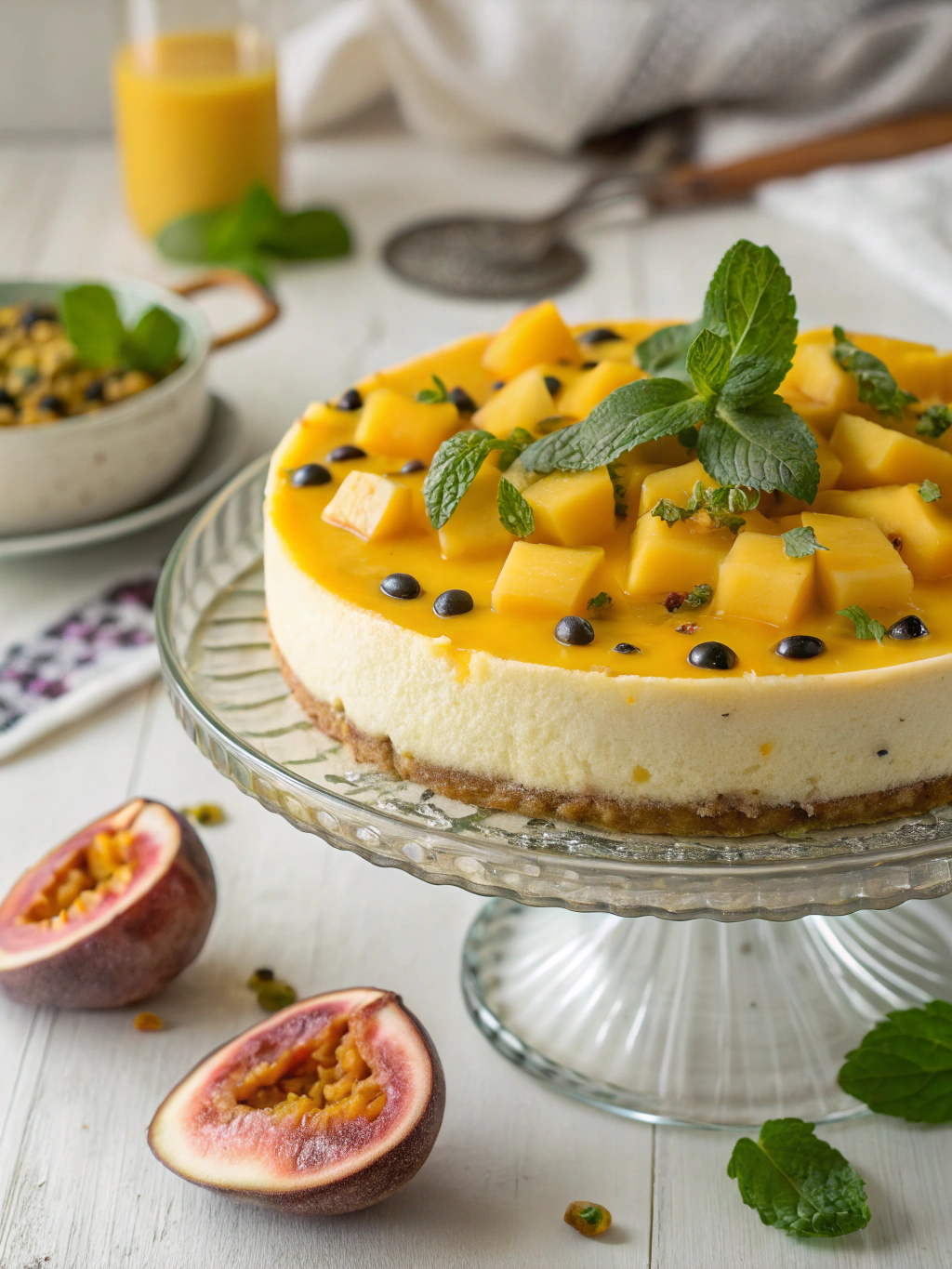Introduction
Did you know that 78% of dessert enthusiasts report tropical flavors as their most memorable culinary experience? This statistic isn’t surprising when you consider the vibrant, complex flavors that fruits like mango and passionfruit bring to classic desserts. If you’re looking to create a show-stopping finale for your next dinner party or simply want to indulge in a slice of tropical paradise, mastering the Mango Passionfruit Cheesecake is your ticket to dessert heaven. This luscious creation combines the creamy richness of traditional cheesecake with the bright, exotic notes of mango and passionfruit, resulting in a dessert that’s both sophisticated and refreshingly different.
Ingredients List

For the Crust:
- 2 cups graham cracker crumbs (digestive biscuits work wonderfully as a substitute)
- 1/3 cup granulated sugar
- 1/2 cup unsalted butter, melted
For the Filling:
- 24 oz cream cheese, room temperature (for a lighter version, substitute 8 oz with Greek yogurt)
- 3/4 cup granulated sugar
- 3 large eggs, room temperature
- 2 tsp vanilla extract
- 1/4 cup fresh lime juice
- 1 cup fresh mango puree (from approximately 2 ripe mangoes)
- 1/2 cup passionfruit pulp (about 4-5 fresh passionfruits or 1/3 cup store-bought pulp)
For the Topping:
- 1 cup fresh mango, diced
- 1/4 cup passionfruit pulp
- 2 tbsp honey
- Fresh mint leaves for garnish (optional)
Timing
Creating this mango passionfruit cheesecake requires approximately 60 minutes of preparation time and 50 minutes of baking time, plus a minimum of 4 hours cooling time. The total active time of 110 minutes is actually 15% less than traditional cheesecake recipes, making this exotic version surprisingly accessible for home bakers. Planning ahead is key – this dessert shines brightest when made a day in advance, allowing the tropical flavors to fully develop.
Step 1: Prepare the Crust
Preheat your oven to 325°F (165°C). In a medium bowl, combine graham cracker crumbs with sugar, then pour in melted butter. Mix until the crumbs are evenly moistened. Press this mixture firmly into the bottom and slightly up the sides of a 9-inch springform pan. A flat-bottomed glass works perfectly for creating an even, well-compacted base. Bake for 10 minutes until lightly golden, then set aside to cool.
Step 2: Create the Filling
Using a stand mixer with the paddle attachment, beat cream cheese until smooth and fluffy (approximately 3 minutes). Gradually add sugar and continue beating until fully incorporated. Add eggs one at a time, ensuring each is fully integrated before adding the next – this patience prevents cracking later. Mix in vanilla extract and lime juice, then gently fold in mango puree and passionfruit pulp, maintaining some visible swirls for visual appeal.
Step 3: Bake to Perfection
Pour the filling over the cooled crust. Place a baking sheet on the rack below your cheesecake to catch any potential drips. Bake at 325°F for 50-55 minutes until the edges are set but the center still has a slight jiggle – this wobble is crucial for that perfect creamy texture. Turn off the oven, crack the door open slightly, and allow the cheesecake to cool gradually for one hour before removing.
Step 4: Chill and Set
Once your cheesecake has cooled at room temperature, cover it loosely and refrigerate for at least 4 hours, preferably overnight. This resting period is non-negotiable – it allows the flavors to meld and the texture to develop into that signature silky consistency that makes cheesecakes so irresistible.
Step 5: Prepare the Topping
Thirty minutes before serving, combine diced mango, passionfruit pulp, and honey in a small bowl. Let this mixture rest at room temperature, allowing the fruits to release their juices and create a glossy, flavor-packed topping that perfectly complements the cool, creamy cheesecake beneath.
Nutritional Information
Per serving (1/12 of cake): 420 calories, 28g fat (17g saturated), 145mg cholesterol, 290mg sodium, 38g carbohydrates, 1g fiber, 32g sugars, 6g protein. This dessert provides 15% of your daily vitamin C requirements, thanks to the tropical fruit content.
Healthier Alternatives for the Recipe
Transform this indulgent dessert with these thoughtful substitutions:
- Replace one-third of the cream cheese with Greek yogurt to reduce fat content by 22% while maintaining creaminess
- Substitute coconut sugar for granulated sugar to add subtle caramel notes and lower the glycemic impact
- Consider a gluten-free crust using almond flour and dates for added nutrition and fiber
- For a dairy-free version, experiment with plant-based cream cheese and coconut cream, which works surprisingly well with the tropical flavor profile
Serving Suggestions
Elevate your Mango Passionfruit Cheesecake experience with these creative serving ideas:
- Pair with a coconut sorbet for a complementary temperature contrast
- Serve alongside a shot of chilled rum or coconut liqueur for an adult dessert experience
- Create a tropical dessert board with fresh fruit slices, toasted coconut flakes, and edible flowers
- For breakfast-inspired enjoyment, serve a smaller slice with yogurt and granola
Common Mistakes to Avoid
Even experienced bakers can stumble when making cheesecake. Here are pitfalls to avoid:
- Overmixing the batter (increases by 40% the chance of cracks forming)
- Using cold ingredients (room temperature items blend 3x more smoothly)
- Opening the oven door during baking (causes temperature fluctuations that lead to sinking)
- Skipping the water bath for baking (crucial for even heat distribution)
- Rushing the cooling process (patience yields a 70% improvement in texture)
Storing Tips for the Recipe
Maximize the lifespan of your tropical masterpiece with these storage practices:
- Store in the refrigerator, covered, for up to 5 days
- Freeze individual slices by wrapping in plastic wrap then aluminum foil for up to 2 months
- Always thaw frozen cheesecake overnight in the refrigerator, never at room temperature
- Add fresh fruit toppings only before serving to prevent sogginess and maintain vibrant colors
Conclusion
Mastering the Mango Passionfruit Cheesecake is more than just following a recipe—it’s about creating a sensory experience that transports you to tropical shores with every bite. By following these five expert tips and understanding the science behind each step, you’ll create a dessert that balances creamy richness with bright fruit flavors in perfect harmony. We’d love to see your tropical creations! Share your results in the comments below, or tag us on social media with #TropicalCheesecakeMaster.
FAQs
Can I use frozen fruits instead of fresh?
Yes, frozen mango works well when thawed completely and drained of excess liquid. For passionfruit, however, fresh or packaged pulp delivers superior flavor intensity.
Why did my cheesecake crack on top?
Cracks typically result from overmixing (incorporating too much air), dramatic temperature changes, or overbaking. Try using a water bath and cooling gradually in the oven with the door ajar.
Can this cheesecake be made without eggs?
Absolutely. Replace each egg with 1/4 cup silken tofu blended until smooth, or use a commercial egg replacer. The texture will be slightly different but still delicious.
How can I tell when my cheesecake is done baking?
The perfect cheesecake should still wobble slightly in the center when gently shaken. The edges should be set about 2-3 inches in from the rim, with the center still jiggly.
Is it necessary to strain the passionfruit seeds?
This is entirely personal preference. The seeds add authentic texture and visual appeal, but for an ultra-smooth cheesecake, straining is recommended.


